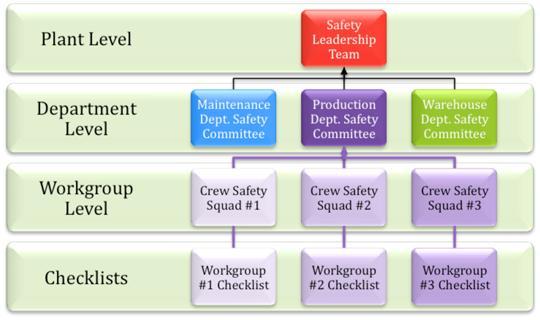by Terry McSween, Ph.D.
One of the questions often asked in early discussions about implementing a Values Based Safety® (VBS) process is, “How many observation checklists are required for an effective process?” Sometimes the question is worded a bit differently, “Can we have an effective behavioral safety process using a single checklist?”
The number of checklists
The answer, of course, is that it depends on an analysis of your significant areas of exposure and your past incidents. My associates and I at QSE typically begin with the assumption that different functional groups are likely to need different checklists. For example, the shipping and receiving area will have a different checklist, as will the QA lab, the production operations group, the maintenance group, and office employees. (We generally do not go deeper into these groups to the point of having a specific checklist for each position or job task. Those are better served with procedures and job-safety analyses). Once we have analyzed key hazards and past incidents, we sometimes find that a single checklist will serve all groups at a location. This is often the case, for example, when the organization has a very consistent process across areas or locations, such as multiple distribution centers.
As the number of employees at a single location grows, so does the likelihood of needing multiple checklists. Among the other elements they must plan, the team designing a new behavior-based safety (BBS) process will need to consider the number of checklists and the committee structure that will best support the process and be responsible for managing the VBS process.
Aligning your safety committees and checklists
A checklist provides a metric of the norms established by the workgroup. While leadership sets the policy and enforces the rules related to lockout/tagout, the workers in the maintenance group are the ones who establish the norms for lockout/tagout practice within their group. The operations group may very well have a different set of lockout/tagout norms for work practices such as clearing jams in their equipment, for example. Thus, because norms vary between groups, each group should have a checklist reflecting their practices.
As shown in Figure 1, a single safety committee is responsible for an area and its corresponding checklist. This allows that safety committee to focus on the data from a single group and use that data to create targeted safety action plans.

Figure 1—A possible safety committee configuration that provides good safety communication to production crews.
Safety Committees are ACTION groups
In a well-designed, BBS process, each workgroup should have a safety committee or team that reviews data from their observation process and develops action plans to address areas of concern. Depending on the size of the workgroup, the committee may have 10-12 participants, or be more of a small squad or team of three or four people. I recently learned of an organization using “safety squads.” I like this terminology, as it implies an action orientation—a group charged with doing something! A safety squad with three people may work less formally than a large committee, yet they can perform the same basic functions: review data, share information during safety meetings, collect input, and develop action plans. When the safety committee or team is at the local level, they are in a better position to know the workgroup norms and develop safety action plans to remove barriers to safety.
Linking Multiple Safety Committees
When the organization has multiple workgroups with department safety squads or teams and multiple, corresponding checklists, they will often have a plant-level safety committee. This committee is typically made up of representatives from the department safety squads. The function of the plant-level committee is sharing of ideas and reporting on improvement targets and action plans from within each of the functional groups. Each department committee has a distinct functional group with a safety observation checklist tailored to each functional group. One member of each level serves as the communication “linking pin” through participation in the group above.
Thinking outside the Box
 I realize this may be a different model for many of you. Too often, we default to a single safety committee with a formal monthly meeting. I hope this article encourages you to consider the possible advantages of pushing analysis of the data down a level or two in your organization. Pushing the analysis of data down a level (or two) in your organization requires two things:
I realize this may be a different model for many of you. Too often, we default to a single safety committee with a formal monthly meeting. I hope this article encourages you to consider the possible advantages of pushing analysis of the data down a level or two in your organization. Pushing the analysis of data down a level (or two) in your organization requires two things:
1. The personnel at each level must have the skills and knowledge to understand the different types of data available from safety observations and be able to develop safety action plans appropriate for their areas.
2. The Safety Leadership Team must provide monthly support for the department safety committees.
This model helps organizations create a framework for managing BBS data at the local level in alignment with your checklists. I realize the “safety squad” concept will not necessarily fit all organizations. As you know, we at QSE are fond of saying, “One size does not fit all.” I encourage you to consider this information and create a model that helps your organization best reach its goals.
How We Can Help: Safety Culture Health Assessments
“It is not the strongest of the species that survives, nor the most intelligent; it is the one that is most adaptable to change.” —Darwin
Designing and rolling out your behavioral approach to safety, leadership, or performance improvement is only the first step in your journey. To sustain your success, refining your methods as circumstances change must become a continuous process. Quality Safety Edge can help by evaluating your process and providing concrete recommendations that you can implement immediately.
During your health assessment, we assess the functioning of each component of your process and compare it to your current—and future—needs. We identify those elements that are underperforming or no longer aligned with your strategy and help you plan to adapt and improve your process for long-term success. Contact us at thesafetyedge for more information.